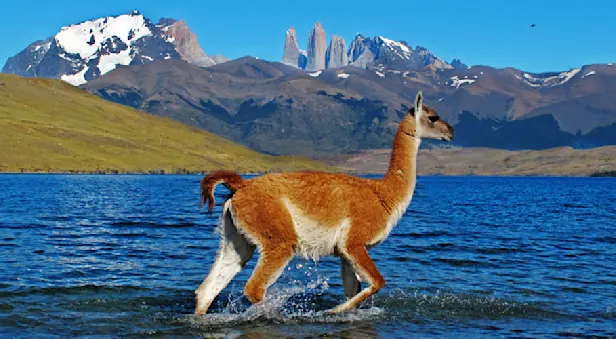Red Fox Facts | Patagonia Wildlife Guide
PHYSICAL CHARACTERISTICS
The red fox is the most widespread member of the order Carnivora, ranging across more than 85 countries, including Chile and Argentina. Despite its name, the red fox has a host of unique mutated colorations, including amber, silver, platinum and gray. The most recognizable, of course, is rusty red with black stockings and white undersides. This creature weighs anywhere from 6.5 to 24 pounds—roughly half the size of a coyote. Slender and sleek, the fox saunters through the underbrush, its pointed ears alert and white-tipped and his brushlike tail aloft.
HOME RANGE
Red foxes are solitary creatures. They are highly territorial of their home range, which is typically about 730 acres and bordered by natural barriers such as rivers. Males have a more extensive home range than females, and dominant individuals usually range over broader areas with a better food supply.
FEEDING HABITS
Red foxes hunt in the cold of winter mornings and evenings, stalking voles, mice, shrews and rabbits in snowy clearings and ponds. Their keen ears pick up the faintest traces of sound, and when alerted to slight stirrings their sharp eyes quickly pinpoint their target. Pouncing upon their prey with a sudden leap, they hold the animal down with both their forepaws and bite down on the neck, making a kill.
As the snow melts, the warmer seasons bring a new supply of nourishment to the fox. As the vibrant green tendrils of plants emerge from the soil with the coming of spring, an abundance of baby mice and voles are born, and eggs of ground-nesting birds provide good eating. The omnivorous fox forages for grasses, tubers and sedges during the summer. In autumn, ripe berries such as raspberries, mulberries and blackberries become a critical food source, as the fox prepares for the impending frozen landscape of winter.
BREEDING
Though typically unaggressive, male foxes engage in feuds and tussles at the beginning of the breeding season. A dominant male will ward off other suitors and mate with a vixen, after which the pair becomes inseparable. They travel the countryside, seeking out a suitable den for the female to have her pups. After a gestation period of 52 days, the vixen gives birth in an abandoned wolf den or excavated rodent burrow on the south side of a hill or stream bank. Four pups are typically born, and the mother is confined to the warm den, caring for her young while the father brings her prey. After a few days, she starts to leave the den for short intervals to hunt. These periods are one of the most vulnerable times for pups, as predators such as pumas may snatch young.
Semi-digested meat is slowly incorporated into the milk diet of pups during their first few months, and at 3 months old, the young are weaned. Playtime aids in developing the agility and speed so critical to the red fox’s survival. Pups learn hunting lessons from their mother, and the young become more and more self-reliant as their skills are honed. In early winter, the family breaks apart, and each fox sets out to find a new home range. Header Credit: Colin McNulty
See Red Foxes on These Patagonia Adventures

Wild Patagonia: Peaks, Glaciers & Pumas
An all-encompassing expedition straddling Chile and Argentina! Marvel at the granite spires of Torres del Paine, survey the vast ice face of Perito Moreno Glacier, search for pumas and see condors soar.



































